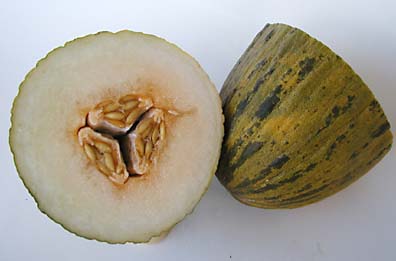
Eleanor Nakama-Mitsunaga
![]()
|

Melons of all varieties are at peak season now. Although honeydews and cantaloupes are most prevalent, other varieties deserve some attention, too. Take for example the Santa Claus melon’ a fairly new variety with a catchy name.
The basics: You would assume that a melon named Santa Claus would be available in December, but actually the season runs from July through October.
The Santa Claus melon, also called Christmas melon, got its name because initially its season peaked in December. But because melons generally sell better in the summer, it is now available in the late summer and fall. California and Arizona are the main producers.
Santa Claus melons are similar in size to Thai watermelons. With their oblong shape and green-and-yellow rind, they also resemble watermelons. The rind, however, has a slight ridged texture with flecks of green rather than stripes.
The flesh is similar to a Canary or honeydew melon -- a creamy white hue tinged with light green and a bit of orange near the seed area. The flavor is also similar to honeydew, though not as sweet. All melons make healthy snacks and are a good source of vitamin C.
The Santa Claus melon has a long storage life and will keep for months under the right conditions.
Selecting: The Santa Claus melon has a thick rind, so the fruit will not exude a fruity melon scent when ripe. The only way to differentiate its ripeness is by coloring. Avoid purely dark green fruit; there should be some light tinges of yellow in the skin. Also, with all melons make sure that the fruit is heavy for its size.
Storing: Santa Claus melons can be stored on the counter for several weeks, but should be refrigerated after cutting. Once cut, the Santa Claus will last a lot longer than other melon varieties.
Use: Rinse the melon thoroughly before cutting. Scoop out the seeds and then slice. The Santa Claus can be enjoyed with other varieties of melon in a fresh fruit salad, or just cut into wedges and served as an accompaniment to sandwiches or other appetizers.
It can also be blended with other fresh fruits into a delicious and healthy smoothie.
Where to buy: Santa Claus melons are not as abundant as other varieties, but should be available at a handful of markets for the next couple of months. Prices run from 99 cents to $2 a pound.

a free-lance food writer. Contact her
online through features@starbulletin.com
